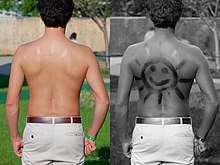This article includes a list of general references, but it lacks sufficient corresponding inline citations. (April 2009) |



Ultraviolet photography is a photographic process of recording images by using radiation from the ultraviolet (UV) spectrum only. Images taken with ultraviolet radiation serve a number of scientific, medical or artistic purposes. Images may reveal deterioration of art works or structures not apparent under light. Diagnostic medical images may be used to detect certain skin disorders or as evidence of injury. Some animals, particularly insects, use ultraviolet wavelengths for vision; ultraviolet photography can help investigate the markings of plants that attract insects, while invisible to the unaided human eye. Ultraviolet photography of archaeological sites may reveal artifacts or traffic patterns not otherwise visible.
Ultraviolet images have no color since ultraviolet radiation is invisible to human eyes.
Photographs of dyes that fluoresce under ultraviolet illumination are examples of ultraviolet fluorescence photography.